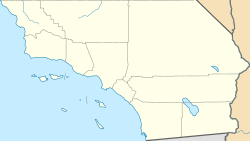Ground Equipment Facility J-36A
This article needs additional citations for verification. (December 2012) |
| Ground Equipment Facility J-36A | |
|---|---|
| Part of 1951: | |
| Locations | |
| Coordinates | 32°58′37″N 118°33′10″W / 32.97694°N 118.55278°W (AFS)[2] 32°53′04.95″N 118°27′04.05″W / 32.8847083°N 118.4511250°W (ARSR-4)[2] |
| Type | radar station |
| Code | ADC: LP-39, P-39 USGS: D-4-66-SC JSS: J-36A |
| Site information | |
| Controlled by | |
| Site history | |
| Built | 1951 |
| In use | ADC: 1951-1960 USGS: 1966 USN: 1972-present |
| Garrison information | |
| Garrison | 670th Aircraft Control and Warning Squadron |
Ground Equipment Facility J-36A (San Clemente Island Air Force Station until 1960) is a Federal Aviation Administration (FAA) radar station of the Joint Surveillance System (JSS) in the Western Air Defense Sector (WADS) of NORAD.
History
[edit]In World War II, Los Angeles Harbor Defenses included posts on some islands of Southern California, e.g. in March 1942, "a 200-man Army detachment set up two radar stations" on San Clemente Island, and in March 1944, Navy "Seabees built two permanent radar installations[where?] on the island."[3]
USAF radar station
[edit]San Clemente Island Air Force Station was Permanent System radar station LP-39 which began operations in November 1951 with an AN/TPS-1C general surveillance radar. Designated as one of two offshore radar stations at the Southern California coast, the 670th Aircraft Control and Warning Squadron was activated at the station on 1 February 1952 by the 27th Air Division. As an AC&W radar station, the facility provided radar tracks for a Manual Air Defense Control Center to direct Ground control interception (GCI) of unidentified aircraft.
The Air Force Station was upgraded to designation P-39 with a single AN/FPS-3 radar in May 1952 and an AN/FPS-4 height-finding radar the following year. In 1955 an AN/FPS-8 was added and subsequently converted to an AN/GPS-3 and in 1956, an AN/FPS-6 height-finder replaced the AN/FPS-4. As with other Air Defense Command stations replaced by facilities of the joint-use site system (JUSS), San Clemente Island AFS was replaced in 1960, and 670th operations moved to the JUSS RP-39 station at San Pedro Hill AFS with barracks at Fort MacArthur near the Project Nike direction center (part of the Los Angeles Air Defense Area).
In 1960, San Clemente Island[verification needed] transferred to the Navy[4] and the USAF operations building was subsequently used as a Navy photo lab (the AFS site is vacant, deteriorating and difficult to reach.)[opinion]
USGS radar station
[edit]In 1966 (July 30-August 9), field activity D-4-66-SC of the United States Geological Survey in the Coastal and Marine Geology Program used San Clemente Island with a Western Electric M-33 radar for a study of the Bathymetry and Structure of San Clemente Island (e.g., the "CURV vehicle of Naval Undersea Research and Development Center, was...used for seafloor sampling.")[5]
Mount Thirst radar station
[edit]In 1972 south of the former AFS, the Navy installed an AN/FPS-20 general surveillance radar at Mount Thirst (32°53′03″N 118°27′03″W / 32.88417°N 118.45083°W). The FPS-20 was later modified to an AN/FPS-93A in an Arctic Tower for range safety and bombing exercises.[6]
Joint Surveillance System
[edit]In the late 1990s, an Air Route Surveillance Radar (ARSR-4) radar at Mount Thirst replaced the AN/FPS-93A, and is now shared with the Air Force for the JSS program[2] (the FAA maintains the radar for the Navy, but reportedly does not use the data).[citation needed]
Station Tombstone
[edit]The late 1980s Station Tombstone Radar, an AN/SPS-73 surface search radar, is located north of Mt. Thirst.[7]
References
[edit]- ^ [full citation needed]
 This article incorporates public domain material from the Air Force Historical Research Agency
This article incorporates public domain material from the Air Force Historical Research Agency
- ^ a b c "Information for San Clemente Island AFS, CA" (Radomes.org database webpage). Air Defense Radar Stations. Retrieved 2013-03-24.
Information for San Clemente Island (Mount Thirst), CA - ^ Shettle, M. L.; Jr. Naval Auxiliary Air Station, San Clemente Island (Report). MilitaryMuseum.org.
{{cite report}}: CS1 maint: multiple names: authors list (link) (transcribed at "San Clemente Island Range Complex". Historic California Posts. The California State Military Museum. Retrieved 2013-03-24. - ^ Winkler, David F; Webster, Julie L (June 1997). Searching the Skies: The Legacy of the United States Cold War Defense Radar Program (Report). U.S. Army Construction Engineering Research Laboratories. p. [verification needed]. LCCN 97020912. Archived from the original on December 1, 2012. Retrieved 2012-03-26.
- ^ Geological and Geophysical data of field activity D-4-66-SC in San Clemente Island, CA from 07/30/1966 to 08/09/1966 (Report). USGS. (abstract retrieved 2013-03-22)
- ^ compiled by Johnson, Mildred W (31 December 1980) [February 1973 original by Cornett, Lloyd H. Jr]. A Handbook of Aerospace Defense Organization 1946 - 1980 (PDF). Peterson Air Force Base: Office of History, Aerospace Defense Center. p. [verification needed]. Retrieved 2012-03-26.
- ^ San Clemente Island Range Complex (SCIRC) Range Sites - Location (Map). publisher tbd. (published in Southern California Offshore Range (SCORE) (Report). 2007.)


